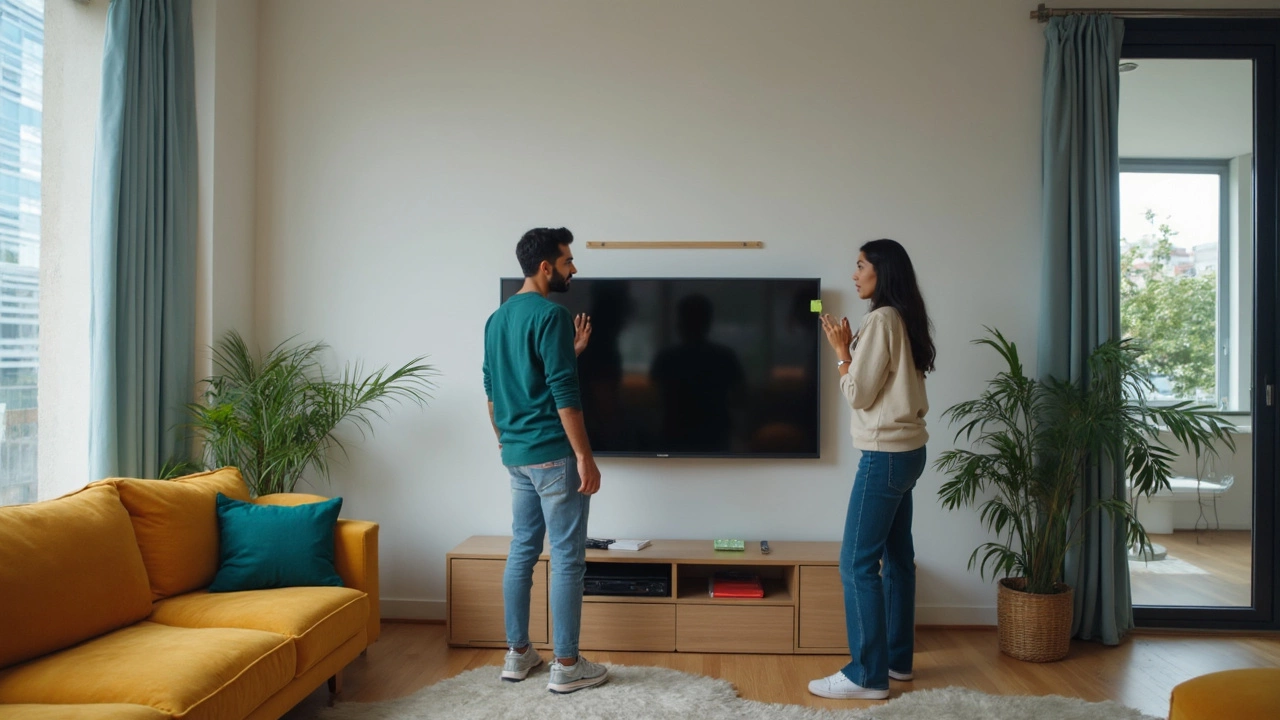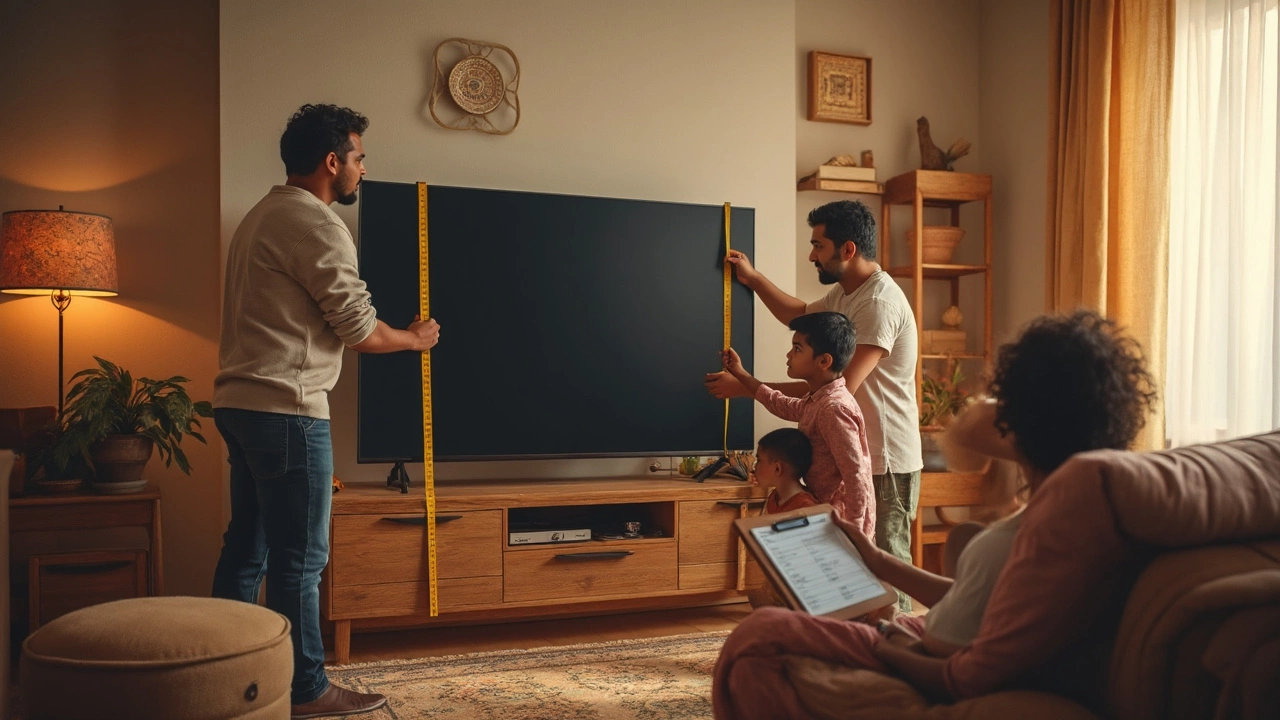Your new 50 inch TV just arrived and now comes the big question: how high should you set it up? Most people get this wrong and either end up with a sore neck or a weird angle that ruins the whole experience. The sweet spot is all about making sure your eyes line up with the center of the screen when you're lounging in your favorite spot.
A simple way to nail this is to sit down on your couch and have someone measure from the floor to your eye level. The ideal spot for the center of your TV is at that exact height—usually, that's somewhere around 42 to 46 inches from the floor for most folks. If you've got a family setup like mine with a kid who loves cartoons, you might want the TV just a little lower so everyone in the house gets the best view.
Some folks try to guess or eyeball it, but a quick check with a tape measure saves you from regrets later. Remember, the bigger the TV, the more dramatic a bad placement feels. You don't want to look up like you're in the front row at the movies—trust me, your neck won't thank you after a Marvel marathon.
- Why TV Height Matters More Than You Think
- The Golden Rule for 50 Inch TV Placement
- Mounting vs. Stands: Pros, Cons, and Surprises
- Fitting the TV Height to Your Space and Lifestyle
- Tips for a Hassle-Free Setup
Why TV Height Matters More Than You Think
Setting your 50 inch TV height isn't just about what looks good on the wall. If you mess up the placement, it can wreck your viewing experience and even cause real discomfort. Ever find yourself constantly shifting on the couch, trying to get comfy while watching? Way too common, and usually it's all about that wrong TV height.
When your TV sits too high or too low, your eyes and neck end up doing extra work. This isn't just annoying—it can actually give you headaches and neck pain, especially after long movie sessions or gaming sprees. The American Optometric Association found that poor screen positioning is a top reason people get eyestrain at home. The ideal setup puts the middle of the TV screen directly in line with your eyesight when you're chilling in your main seat. That keeps your posture relaxed and your eyes happy.
Modern TVs may look amazing, but their crystal-clear picture is built for a direct view. Mounting too high not only strains your neck—it can mess with color and contrast because of how LED screens work. And if you're into sports or action flicks? A bad angle means you'll miss details you wouldn't even realize you're missing till you fix it.
Piling books or buying a random stand isn’t the answer. TV stands need to fit both the space and your eyesight. Here's a quick breakdown of how screen placement can affect comfort and quality:
| TV Height Issue | Common Problem | Solution |
|---|---|---|
| TV too high | Neck pain, poor colors | Lower stand, eye-level mounting |
| TV too low | Slouching, eyestrain | Higher stand, adjust seating |
| Glare from windows/lights | Washed out image | Move TV/stand, add curtains |
Getting the tv placement right isn't just a nice-to-have—it's key to setting up the perfect binge-watching zone. Nobody wants to ruin movie night because of neck twinges or dull picture quality. The right height transforms your whole experience. Next, let's crack the code on how to pick that sweet spot for a 50 inch screen.
The Golden Rule for 50 Inch TV Placement
Alright, here’s the go-to rule backed by TV experts and installers: the center of your 50 inch TV should line up with your eye level when you’re sitting down. It’s not about what looks best on the wall—it’s about what feels best during movie night or while you’re gaming.
The sweet spot is usually having the middle of the TV about 42 inches from the floor, but it really depends on your seating height. To get it right:
- Grab a tape measure and sit in your usual spot (couch, recliner, gaming chair, whatever).
- Measure from the floor to your eyes. Most adults land in the 40-45 inch range, but don’t assume—every living room is a little different.
- Mark that height on the wall. That’s where you want the center of your TV to be.
For a 50 inch TV, the screen is about 24.5 inches tall. If you’re using a stand, check the TV’s actual viewing area and factor in any frame or base. Mounting on the wall? Use a level and make sure the center hits your mark, not just the bottom edge. Don’t forget to account for how high your stand holds the TV if you aren’t mounting it.
Some folks try hanging the TV higher, thinking it’ll look more stylish. But here’s the deal: anything much higher than your eye line, and you’ll notice neck strain—a study by the Journal of Ergonomics found that neck and back discomfort shoots up when screens get placed as little as 15 degrees above natural eye level.
If you want the quick math: your eye level height = the height from the floor to the middle of the TV. For a typical 18-inch couch seat, that average 42-inch TV midpoint is golden. If your crew is taller or you love lying on beanbags during movies, just match the TV center to wherever your eyes hit the wall. No fancy formulas needed—just straight-up comfort.

Mounting vs. Stands: Pros, Cons, and Surprises
The classic debate—do you mount your 50 inch TV on the wall, or keep it on a stand? Each option has its own perks and a few headaches. It really comes down to your space, style, and how often you like to move stuff around.
Wall mounting is awesome if you want that clean, modern look. You save floor space, which is a big deal in apartments or smaller rooms. The big pro is you’re in total control of the viewing height, so you can follow the golden rule: center the screen at your eye level. On the flip side, mounting locks you into one spot—changing your room layout later means dealing with holes in the wall and possibly buying a new bracket. And if you rent, check whether your landlord is cool with drilling.
- Looks sleek, no bulky furniture
- Easier to keep cords out of sight
- Can be tricky to install—usually a two-person job
- Not easy to reposition if you move your couch around
TV stands are all about flexibility. You just set up, plug in, and watch—no drills, no wall anchors. If you have game consoles, soundbars, or DVD players (my kid Otis is obsessed with old DVDs), it’s super handy to tuck them underneath or beside. But the main problem is not every tv stand puts the screen right at the best tv placement height, so sometimes you’ll need to buy a taller stand or prop things up a bit to avoid that chin-down slump.
- Instant setup, no wall damage
- Easy to move for cleaning or rearranging rooms
- More storage for other tech and gadgets
- May need to adjust height so it’s not too low
Surprise fact: According to a 2023 home design survey, about 54% of people with TVs over 48 inches still use stands. Stands are still winning in family homes, likely because they’re way less hassle to install and safer if you rearrange your space a lot.
| Feature | Wall Mount | TV Stand |
|---|---|---|
| Space Saving | Yes | No |
| Easy Installation | No | Yes |
| Flexible Placement | No | Yes |
| Cable Management | Hidden | Potentially Messy |
Whatever you choose, make sure your 50 inch TV height lines up with where your eyes naturally land when sitting. Even a great setup can feel off if the angle's not right.
Fitting the TV Height to Your Space and Lifestyle
The perfect 50 inch TV height isn't a one-size-fits-all number. The room size, your seating setup, and how you use your TV all come into play. For example, if you’re using a reclining sofa, your line of sight changes compared to a straight-backed chair in a small apartment. Not everyone has a huge open living room—sometimes you’re squeezing your TV into a cozy den or even a bedroom.
If you love binge-watching from bed, consider mounting your 50 inch TV slightly higher. Lying down flattens your view, so bringing the TV up six or eight inches over the usual center-of-screen guideline can make a big difference. In a family room where kids often sit on the floor, you might want the TV a bit lower so everyone gets a good view.
Living rooms with fireplaces or built-in shelves can mess up your perfect plan. Mounting above a mantle is tempting, but keep in mind: setting the TV too high can be tough on your neck. A 2023 survey of TV owners found that nearly 38% regretted putting their set above a fireplace because it felt awkward to watch for long periods.
Here’s a quick reality check for fitting TV height to your space:
- Measure the distance from your main seat to the TV. For a 50 inch TV, seven to ten feet is the ideal viewing range.
- Mark your eye-level (when sitting how you usually relax) on the wall—this is where the center of the screen should land.
- Test the view: use painter’s tape to outline your TV spot on the wall, then sit down and pretend you’re watching your favorite show. Does it feel natural?
- Factor in stands or consoles. Most tv stands are 20-30 inches tall, so account for that height when figuring out where the bottom of the TV will sit.
- Adaptive arrangements matter! Have pets, kids, or multi-use spaces? Go for flexible options like adjustable mounts or mobile tv stands.
Here’s a quick look at how different room setups might affect the TV height:
| Room Type | Recommended TV Center Height (inches) |
|---|---|
| Living Room - Sofa | 42-46 |
| Bedroom - Bed Viewing | 48-54 |
| Kids Playroom - Floor Seating | 36-40 |
| Multi-Level Rooms | Varies, test first |
Take a few minutes to customize your tv placement and you’ll avoid eye strain, neck aches, and grumbling from the rest of the household. Every room—and every lifestyle—just needs a small adjustment for that perfect view.

Tips for a Hassle-Free Setup
No one likes putting a hole in the wall just to realize the TV is a little too high—or worse, not even facing the couch. Getting your 50 inch TV height right doesn't have to be a pain. Here’s how to keep things simple and get it spot-on the first try:
- Test the Height Before Mounting: Lay out some painter's tape on the wall to mark the spot where the center of your TV will be. Sit down and look at that spot. If it feels natural and is level with your eyes, you’re golden.
- Check Stud Placement: Most modern TVs, especially 50 inch TVs, need sturdy backing. Use a stud finder and make sure you're not mounting into just drywall. No one wants a crash landing at 2am.
- Cable Management: Hiding cords makes the living room look cleaner and keeps things safe if you’ve got curious kids like Otis. Use cord covers or even run the wiring inside the wall if you’re up for some DIY.
- Mounting Height: For a tv stand setup, double-check that your stand lifts the screen so the midpoint hits eye level from a seated position. Want exact numbers? For a 50 inch TV, that usually means the bottom edge should be about 25-30 inches from the floor.
- Final Check: Before you tighten mounts or push stands into place, sit where you actually watch. Watch a few minutes of a show to see if the angle holds up—you’ll spot an awkward tilt right away.
Here’s a neat little fact: Streaming TV experts at RTINGS found that the most common ‘comfortable viewing height’ was “centered at eye level, roughly 42 inches for an average sofa height.” That echoes what most installers stick to. As the pros at CNET put it:
“If you're always looking up at your TV, it's too high. The center of the TV, or slightly lower, should be right at eye level, especially when seated.”
Want some quick numbers? Check the table below for the recommended heights for different tv placement styles:
| Placement Type | Mid-Screen Height from Floor |
|---|---|
| Wall Mount | 42-46 inches |
| TV Stand | 40-45 inches |
| Bedroom (lying in bed) | Lower, around 36-40 inches |
One last tip: Always double-check the VESA mount size on your TV and the bracket. Nothing ruins setup day like a bracket that almost fits. When in doubt, ask at the store or online support—they’ll usually answer in no time.

